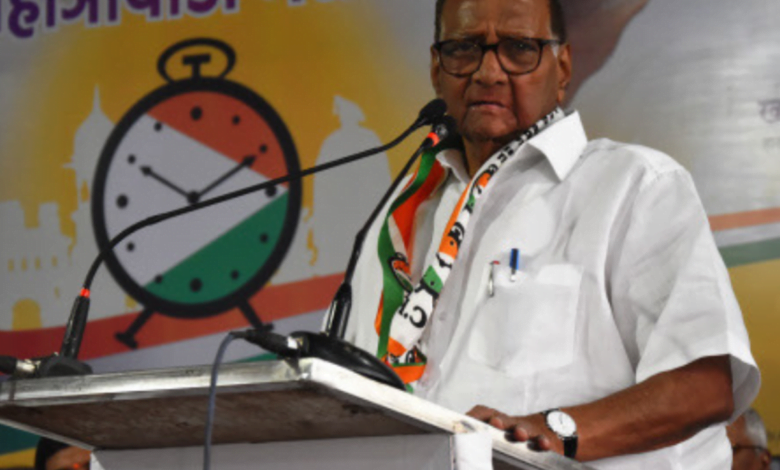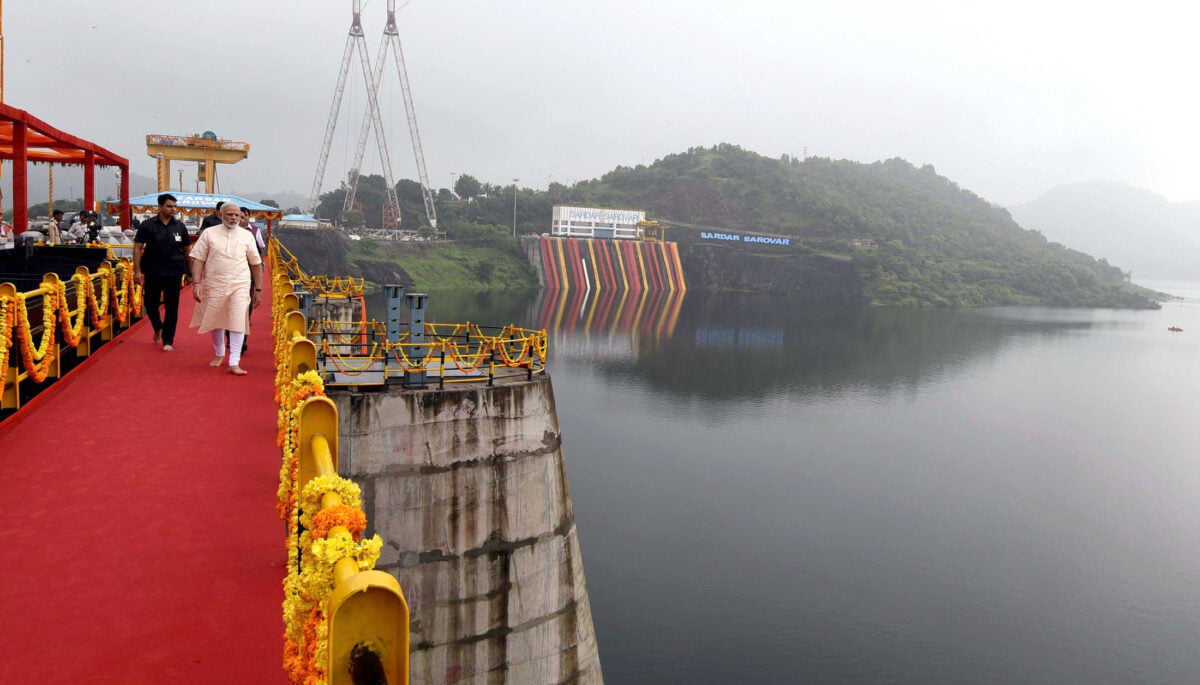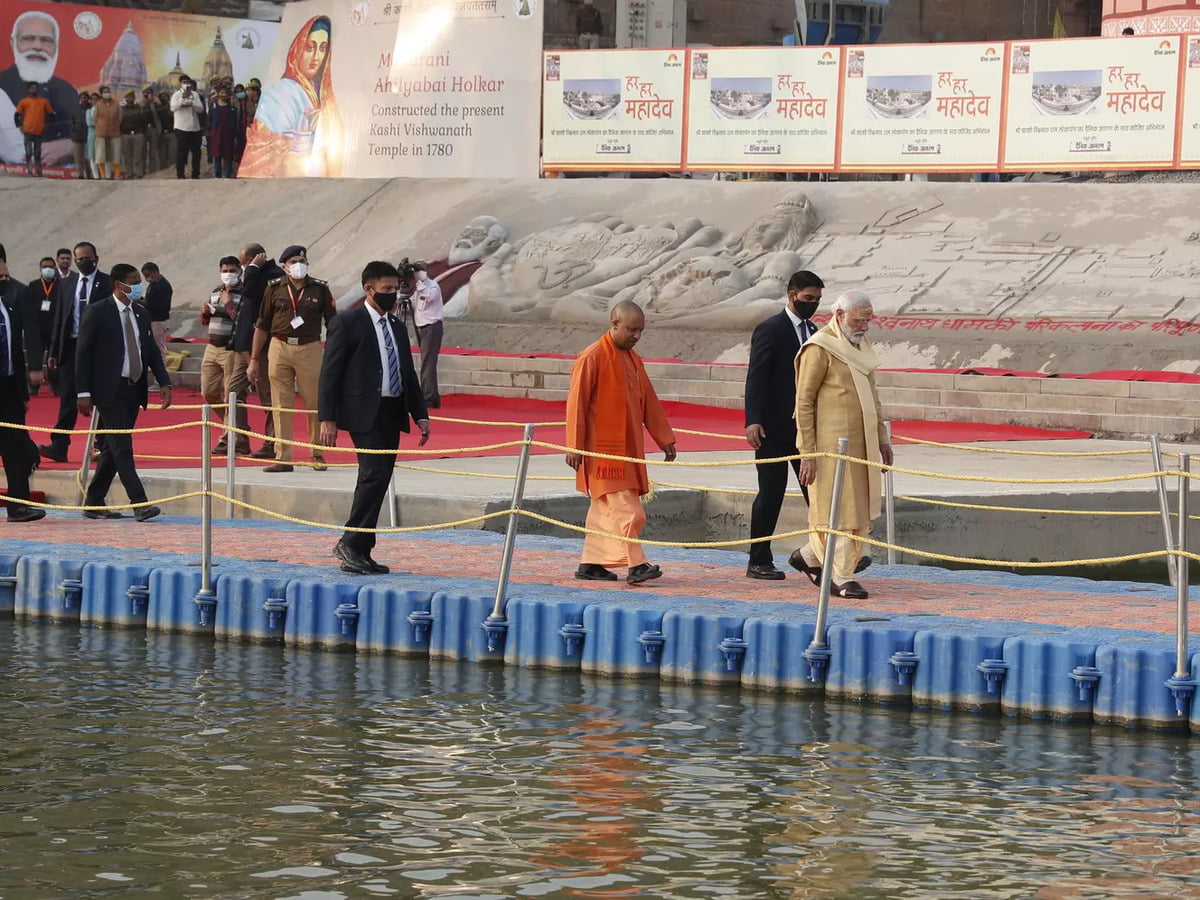After the Gujarat Model of Development, India Presents the Uttar Pradesh Model

After the Gujarat model of development, India presents the Uttar Pradesh model
Gujarat, with a population of 60.4 million people, is a state on India’s western coast with a 1,600-kilometer (990-mile) coastline, the majority of which is on the Kathiawar peninsula. It is India’s fifth-largest state by land area and ninth-largest by population. Rajasthan borders Gujarat on the northeast, Dadra and Nagar Haveli and Daman and Diu on the south, Maharashtra on the southeast, Madhya Pradesh on the east, and the Arabian Sea and Pakistan’s Sindh area on the west.
The capital is Gandhinagar, while Ahmedabad is the largest city. The Gujarati people of India are native to the state, and Gujarati is the state’s official language. Gujarat has India’s fifth-largest economy, with a gross state domestic product (GSDP) of 16.48 trillion dollars ($220 billion) and the country’s tenth-highest GSDP per capita of 243,761 dollars ($3,200). In terms of human development, Gujarat is ranked 21st among Indian states. The state has a long history of low unemployment and is primarily regarded as one of India’s most industrialized manufacturing hubs.
There are 23 historic Indus Valley Civilisation sites in the state (more than any other state). Lothal (the world’s first dry dock), Dholavira (the sixth largest site), and Gola Dhoro are the most important (where 5 uncommon seals were found). Lothal is regarded as one of the world’s first seaports. During the Maurya and Gupta empires, as well as the succession of royal Saka dynasties in the Western Satraps era, Gujarat’s coastal cities, particularly Bharuch and Khambhat, served as ports and commerce centres. Gujarat is one of four Indian states that prohibits alcohol, along with Bihar, Mizoram, and Nagaland. The world’s only wild population of Asiatic lions is at Gujarat’s Gir Forest National Park.

What is the Gujarat model?
In simple terms, it refers to the era from 2002-03 to 20011-12, when Gujarat’s growth rate increased dramatically. The then-chief minister, Narendra Modi’s creative interpretation of neoliberal policies, was the driving reason.
The three major components of the growth strategy were:
- A quantum leap in infrastructure to facilitate the inflow of corporate investment.
- A quantum leap in governance to address the needs of corporate units.
- There is an unprecedented increase in incentives and subsidies on investments to the corporate sector to attract investments.
Roads, airports, and power were prioritized in infrastructure development, with 24-hour power availability achieved through reforms.
Governance centred on a single point of contact for investment offers, easy access to bank loans, and, if needed, other escort services for corporate units and their core staff. To promote investment flows, the concerned departments were aggressive in expediting procedures. Until 2006-07, the major incentives for corporate investment were sales tax exemptions (till the Centre banned it). Sales tax revenue, which is the primary source of income for state governments, was cut by 40%.
Following that, the government implemented capital, interest, and infrastructure subsidies and substantial contributions to land, water supply, and natural resources. Subsidies were more generous for more significant investments. There was no set rate for big industries, and each case was evaluated individually. Tata-Nano, for example, received a total subsidy of Rs 30,000 crores (like Suzuki, Hyundai etc.). Common grazing land, denotified protected areas, national parks, and irrigated rich lands were all used to gain land. The price began at Re 1 per acre and grew over the model’s final years, but it was still cheaper than the market price.
Expanding global markets also aided the expansion. Gujarat boosted exports in all major industries, including petrochemicals, chemicals, pharmaceuticals, textiles and garments, leather, machine tools and electronics, gems and jewellery, and crops, by establishing several special economic zones (SEZs), industry parks, and special export promotion measures.
Gujarat also saw substantial agricultural growth (7-8 per cent) during this time, thanks to nearly nine years of consistent good rain and government initiatives on improved seeds (although cotton was the big winner), extension through Krushi Rath, modern agricultural practises, and 24-hour power for farmers.
However, droughts and water shortages in 2011-12 lowered the rate to 3.7 per cent, with large swings. Furthermore, agriculture is harmed by a low minimum support price (cultivation costs are substantially greater), inadequate crop insurance (even in solid areas, coverage is just 10-12 per cent), and falling public investment in agriculture. Furthermore, this expansion is neither sustainable (groundwater, a primary source of irrigation, is rapidly depleting without adequate recharge efforts) nor equitable (marginal farmers have received few benefits, and agricultural wages for the growing number of agricultural workers are near the lowest in the country).

What was the overall economic impact of this massive increase in company investment and growth?
Following the massive business incentives, the government is left with insufficient finances for education, health, the environment, and mass employment. Gujarat spends less than 2% of its income on education (the national average is 5-6%), resulting in 45 per cent of workers being illiterate or only having completed the fifth grade, with poor quality education.
The rising number of unemployed engineers and scientific graduates is also due to the poor quality of higher education. Health spending accounts for only 0.8 per cent of state income, significantly below the typical of 4-6 per cent. Gujarat is rapidly deteriorating in almost all health parameters. In the state, 45% of children are malnourished, and the incidence of maternal mortality has slowed, resulting in the state’s bad rating.
The state’s politicians brag about having the second-highest labour participation rate in the state (after Haryana), although only 6.8% of the workforce is formal (this per cent is declining as against the rising trend in most other states). Nearly 93-94 per cent of workers are employed in the informal and traditional sectors, which pay low wages and provide no social insurance.
Gujarat has almost the lowest pay rates among India’s central states, with the state’s ranking dropping over the last decade or so. The pursuit of “state-of-the-art” technology has made growth extremely capital expensive. For productive industries, the employment elasticity of expansion has plummeted. One of the state’s most difficult tasks is to create a large number of productive jobs with fair pay for the youth. This failure is at the root of the current agitations in Gujarat.
Even though 40-45 per cent of Gujarati households rely on natural resources for their livelihoods (farming, animal husbandry, dairy, forestry, fishery, and so on), depleted and degraded resources, as well as heavy pollution, have reduced productivity and income in these sectors, increasing their vulnerability. Despite the false assertions, the tribal people are the most harmed by the expansion. Thousands of people have been forced to squat on city streets or live in makeshift huts in rural areas without access to essential services. It’s no surprise that the Gujarat high court has often chastised the state administration, reminding it that they are also a part of the state’s population.
As a result, 40 per cent of the population lives in poverty on multiple levels. The expansion is exclusive and does not reach the majority. Although there are some federal and state anti-poverty programmes, their execution is inadequate. To summarise, the Gujarat model’s hoopla is phoney and deceptive.
Let’s take a look at Uttar Pradesh (UP):
Uttar Pradesh (UP) is a northern Indian state. With nearly 200 million inhabitants, it is India’s most populous state and the world’s most populated nation subdivision. It was created in 1950, when India became a republic. It was a successor to the United Provinces (UP), which was a successor to the United Provinces (UP) created in 1935, and eventually of the United Provinces of Agra and Oudh established in 1902 during the British Raj during the Dominion of India (1947–1950).
With Lucknow as the state capital and Allahabad as the judicial capital, the state is divided into 18 divisions and 75 districts. Uttaranchal (now Uttarakhand) was formed from Uttar Pradesh’s western Himalayan hill area on November 9, 2000. The state’s two major rivers, the Ganges and it’s tributary Yamuna, meet at Allahabad’s Triveni Sangam, a Hindu pilgrimage destination. Gomti and Saryu are two other major rivers. The state’s forest cover accounts for 6.1 per cent of its total area. Cultivable land accounts for 82 per cent of total geographical area, with net sown land accounting for 68.5 per cent of cultivable land.
Rajasthan to the west, Haryana, Himachal Pradesh, and Delhi to the northwest, Uttarakhand and an international border with Nepal to the north, Bihar to the east, Madhya Pradesh to the south, and Jharkhand and Chhattisgarh to the southeast, the state is bordered by Rajasthan, Haryana, Himachal Pradesh, and Delhi. It is the fourth-largest Indian state by area, covering 240,928 km2 (93,023 sq mi), or 7.3 per cent of India’s total area.

What is UP Model?
Because of chief minister Yogi Adiyanath’s allegedly strong reaction to the coronavirus epidemic, the BJP’s hegemonic UP model has received some positive attention. The development of confinement zones and strict implementation of the lockdown have been regarded as major reasons why UP has done better than other states. However, the verdict on UP’s performance is still out because there is no proof that the administration responded systematically or effectively. In comparison to the rest of the country, testing rates in UP are low, and the return of migrant workers has increased in infections and exacerbates the employment situation.
The BJP’s resounding victory in the assembly elections in 2017 was predicated on a campaign that overtly pitted Hindus against Muslims. The party’s top officials implied that the majority community had not been treated fairly under previous regimes. The nomination as chief minister of an authoritarian (rather than populist) like Yogi Adityanath, whose entire politics centred around a militant style of Hindutva and fueled anti-Muslim hate, was a watershed moment in the process.
In the haste to deepen majoritarian consolidation, an undemocratic model of governance gained traction, typified by the degradation of civil and political rights as well as a wave of anti-Muslim hatred. The UP paradigm appears to be based on the concept that law enforcement is not a tool for securing justice but rather a tool for imposing heavy punishments for crimes that the government alleges have been committed, regardless of whether they have been committed or not.
The harsh suppression of rallies against the Citizenship (Amendment) Act (CAA) is by far the most visible manifestation of communal authoritarianism, which is the model’s backbone. Nowhere was the crackdown more brutal and blatantly communal in subverting justice and seeking vengeance on a community. Muslims were the primary victims of official brutality, and the state of Uttar Pradesh suffered the most casualties during the demonstrations.
Notices demanding monetary damages for alleged acts of vandalism of public property were served around the state. Posters with images and addresses of those filled with recovery notices were displayed at prominent crossroads in Lucknow. Even by UP’s standards, this decision was a new low. No other state has gone that far. Public protests were prohibited or dealt with harshly by selectively using the legal system to deter Muslims from speaking out against a discriminatory statute.
The pandemic presents an opportunity:
Meanwhile, the COVID-19 epidemic provided an occasion for even more communal-authoritarian inclinations to be played out. Like many other BJP politicians, the chief minister blamed the Tablighi Jamaat alone for the spread of the coronavirus. This debate was utilized to effectively broaden the terrible arc of communal politics and incite social tensions on purpose. Eight of Lucknow’s 18 coronavirus hotspots were named after mosques, giving the disease a sectarian flavour and blaming one group for it.
The punitive attitude to protest and citizenship (which is already weak in UP compared to other states like Kerala) was extended to the health crisis, which was quickly converted into a law and order issue – a unique aspect of the UP model. The government has taken advantage of the outbreak to get broad powers to tackle the virus. If a person causes death by “deliberate affliction” of contagious disease, an ordinance was created that stipulates a maximum penalty of life imprisonment. Despite the difficulty of establishing criminal intent, there is much room for governmental actors to act arbitrarily. Most of the information will be used against Muslims accused of hiding and spreading the sickness.
The Uttar Pradesh administration quickly dismantled labour rights by taking advantage of the shutdown. On May 6, the Uttar Pradesh cabinet issued an ordinance suspending 35 of the state’s 38 labour laws. All laws, rules, and regulations governing factories, shops, and offices are suspended for three years, except three. If the Centre passes the ordinance, it will result in far-reaching changes that will violate fundamental rights and significantly impair employees’ conditions.
Adityanath recently stated that states hiring migrant workers from Uttar Pradesh must obtain authorization from his government, but then seemed to backtrack on his statement. If such a step were to be adopted, UP would reach a point where, in the words of Ayn Rand, “the government is free to do whatever it wants, while citizens may act only with permission.”
Because it infringes on the fundamental right to free movement, such a judgement will be challenged in court. No citizen’s freedom to travel freely can be taken away from them without due process of law. Furthermore, the state is unable to absorb all of the returning workers. In terms of absolute numbers, UP has the highest unemployment rate in the country. The UP model, unlike the Gujarat model, is not known for its rapid economic growth. UP’s per capita income is half that of the national average.

The dignity of workers given short shrift:
When the UP government declined the Congress party’s offer to provide buses to transport lakhs of migrant workers who are still travelling hundreds of kilometres under the sweltering sun to reach their communities, the professed concern for worker dignity was given short shrift. This exacerbated the structural problems that millions of people in the informal sector face due to numerous state and federal government acts of commission or omission.
The plan would have been approved by any state government functioning in the interests of workers, but the UP government did not. It is fearful of Congress making electoral gains in UP during the lockdown, but this does not justify attempts to prevent workers from receiving assistance, especially when the government has been unable to assist them properly. Workers are forced to relocate to more developed states because of the state’s underdevelopment and inability to provide gainful employment.
Since the BJP acquired an overwhelming majority in 2017, the issue has been hardening authoritarianism. The UP government’s actions show that it views democratic rights as a barrier to majoritarian consolidation and the strategy of mobilizing Hindus, who have traditionally been divided along caste lines, into a larger voting bloc.
Long before the virus, UP has been witnessing a democratic fall. The political background and the determination to recoup damages from anti-CAA protestors and the suspension of labour regulations are two major moves toward forming a communal-authoritarian regime and advancing the Hindutva agenda.
Edited and published by Ashlyn




